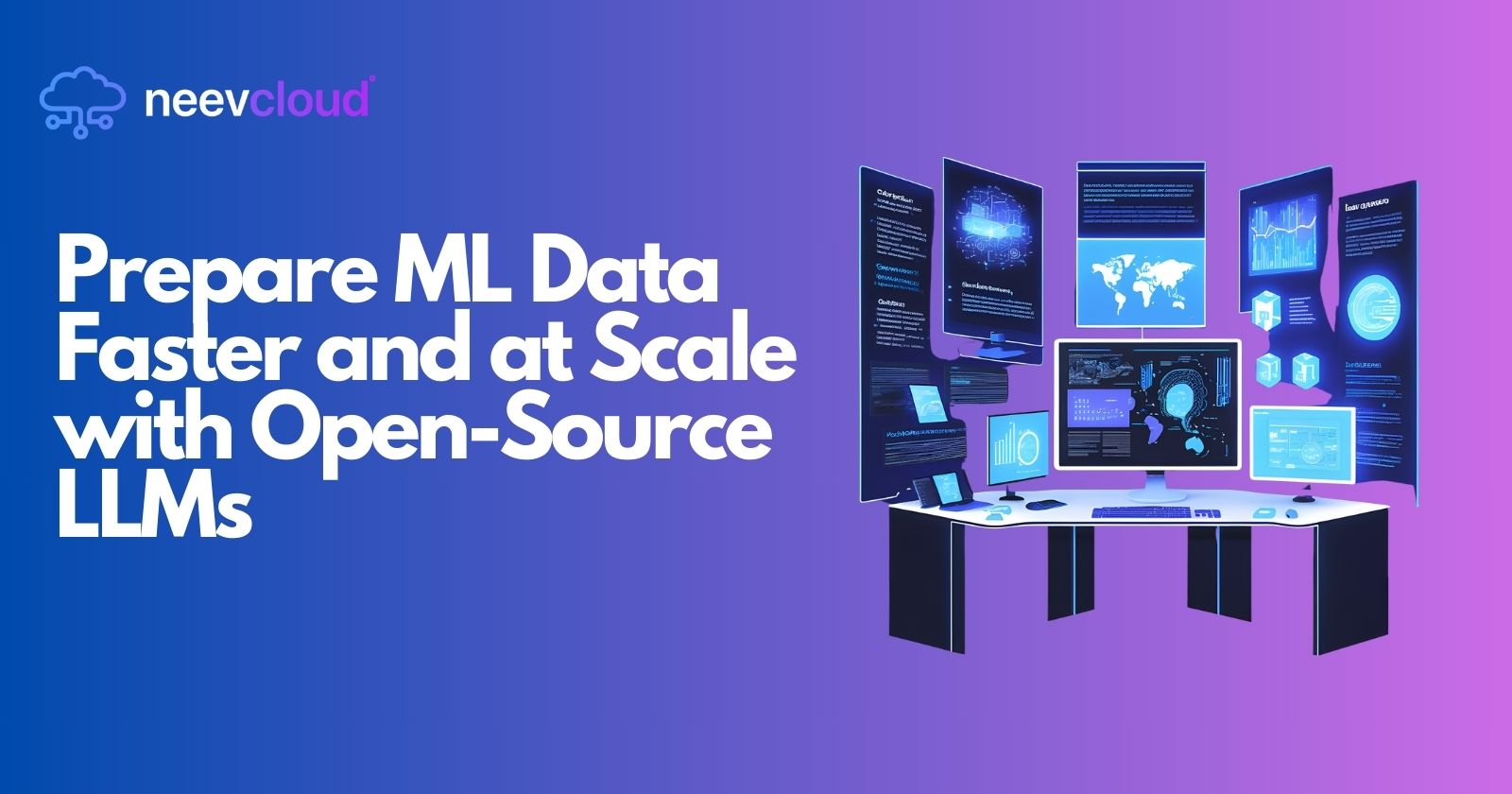Prepare ML Data Faster and at Scale with Open-Source LLMs
 Tanvi Ausare
Tanvi Ausare
Machine learning projects, particularly those relying on vast datasets, can often be slowed down by the data preparation process. However, with advancements in open-source large language models (LLMs) and the emergence of powerful AI Cloud platforms, organizations can accelerate data preparation, reduce costs, and achieve scalable data processing. This blog will walk you through how open-source LLMs can transform your ML data pipeline in an AI datacenter environment, with a specific focus on handling data at scale.
Why Accelerate Data Preparation with Open-Source LLMs?
Increased Data Volume: With digital transformation, organizations handle unprecedented amounts of unstructured and structured data. Manually processing this data is not only time-consuming but also prone to error.
Efficiency in Data Preparation: Open-source LLMs offer sophisticated tools to quickly categorize, clean, and annotate data, making them invaluable in large-scale ML projects.
Cost-Effectiveness: Unlike proprietary models, open-source LLMs significantly reduce operational costs, allowing businesses to allocate resources toward model training and deployment.
The Role of AI Cloud in Scaling ML Data Preparation
An AI Cloud offers the necessary infrastructure for processing ML data on a large scale, enabling efficient data handling through distributed compute resources. Here’s why AI Cloud is essential for managing data with open-source LLMs:
Compute Power on Demand: AI Clouds provide scalable computing resources, allowing you to process large datasets without needing a dedicated on-premise setup.
Seamless Integration with Open-Source Tools: AI Cloud platforms are often compatible with open-source frameworks, facilitating the integration of LLMs.
Enhanced Data Security: AI Clouds housed in AI datacenters offer robust security measures, including encryption, to protect sensitive data.
Automated Data Pipelines: With AI Cloud services, companies can automate data ingestion, transformation, and validation, significantly reducing manual intervention.
Key Open-Source LLMs for Data Preparation at Scale
Hugging Face Transformers
Diverse Pretrained Models: Includes BERT, GPT, and T5 models for tasks like text generation, classification, and summarization.
Efficient Annotation: Automates text annotation for NLP tasks, cutting down hours on manual labeling.
Flexible Deployment: Hugging Face models can run on multiple platforms, including AI Clouds, to optimize compute usage.
SpaCy
Advanced NLP Features: SpaCy provides tokenization, POS tagging, dependency parsing, and named entity recognition, streamlining NLP workflows.
Optimized for Large-Scale Data: Built to process large volumes of text data efficiently, ideal for real-time processing in an AI datacenter.
Integration with Deep Learning Libraries: Works seamlessly with TensorFlow, PyTorch, and OpenAI’s transformers, enhancing its application range.
Apache Spark with MLlib
Distributed Data Processing: Leverages distributed computing to handle large datasets, which is crucial in an AI datacenter setting.
Supports Multiple ML Tasks: Apache Spark MLlib includes tools for classification, regression, clustering, and recommendation systems.
Integration with AI Cloud: Works well with major cloud providers, facilitating seamless scale-up for machine learning projects.
Advantages of Using Open-Source LLMs in Data Preparation
Cost Efficiency: Open-source models eliminate license fees and offer extensive community support, reducing operational costs.
Customization Potential: Unlike proprietary models, open-source LLMs are highly customizable to align with unique data preparation needs.
Continuous Improvement: Open-source communities regularly update these models with improvements, ensuring unique performance without additional costs.
AI Datacenter and Data Security in ML Data Preparation
Deploying LLMs in an AI datacenter offers high-end data protection features to secure sensitive information during data preparation. Key benefits include:
Secure Access Controls: Regulates data access, ensuring that only authorized users can manipulate sensitive datasets.
End-to-End Encryption: Protects data during transfer and storage, preventing unauthorized access.
Scalable Security Solutions: AI datacenters can scale security measures in line with data processing demands, accommodating fluctuations in data volume.
Strategies for Effective Data Preparation with Open-Source LLMs
Data Cleaning and Preprocessing
Automated Text Standardization: LLMs can automatically clean and standardize text, eliminating typos, grammar inconsistencies, and irrelevant content.
Noise Reduction: Removes unwanted data points such as outliers and duplicate entries, streamlining the dataset for model training.
Data Annotation and Labeling
Automatic Text Labeling: LLMs can auto-annotate text data based on predefined categories, saving significant time in NLP projects.
Entity Recognition for Richer Datasets: Recognizes named entities and labels them, enriching the dataset’s contextual understanding for downstream applications.
Data Transformation and Encoding
Tokenization and Encoding: LLMs tokenize text into meaningful representations, a necessary step in machine learning pipelines.
Custom Data Encoding: Open-source tools allow customization of encoding schemes, which can be adapted to unique project requirements, enhancing model accuracy.
Scaling Data Processing with AI Cloud Resources
Load Balancing and Distributed Processing: Leverage AI Cloud to split data across multiple nodes, ensuring faster processing times.
Parallelized Data Transformations: Distribute transformations across compute nodes in the AI datacenter, reducing bottlenecks in data pipelines.
Challenges of Using Open-Source LLMs for Data Preparation
Computational Demand: Large language model require considerable computational resources, which can increase operational costs if not optimized.
Model Optimization: Tuning LLMs for data preparation tasks requires expertise in model optimization, which may be resource-intensive.
Data Privacy Concerns: Handling sensitive information, especially when dealing with PII, requires careful implementation of data governance policies.
Tips for Overcoming Common Challenges
Use AI Datacenter Services: AI datacenters offer advanced resource management tools to mitigate high computational costs, including on-demand scaling and resource allocation.
Leverage Pretrained Models for Specific Tasks: Using models fine-tuned for specific tasks (like sentiment analysis or summarization) can reduce training time and computational load.
Implement Data Anonymization: For sensitive data, implement anonymization techniques to safeguard privacy while retaining data utility.
Future Trends in ML Data Preparation with Open-Source LLMs
Growth of AI Cloud Infrastructure for Open-Source Tools: AI Cloud providers are increasingly offering optimized infrastructure for open-source models, reducing deployment time.
Advancements in LLM Efficiency: Newer versions of open-source LLMs are becoming more computationally efficient, allowing more complex models to run on standard hardware.
AI-Driven Data Governance Tools: Integrating AI with data governance tools will help organizations manage data compliance requirements seamlessly, even in large datasets.
Conclusion
Using open-source LLMs on an AI Cloud platform transforms ML data preparation, making it faster, cost-effective, and scalable. By leveraging advanced LLMs within an AI datacenter, businesses can streamline their ML workflows, ensuring that data preparation is no longer a bottleneck but a competitive advantage. Embrace these technologies and keep an eye on emerging trends to stay at the forefront of ML innovation.
Subscribe to my newsletter
Read articles from Tanvi Ausare directly inside your inbox. Subscribe to the newsletter, and don't miss out.
Written by
